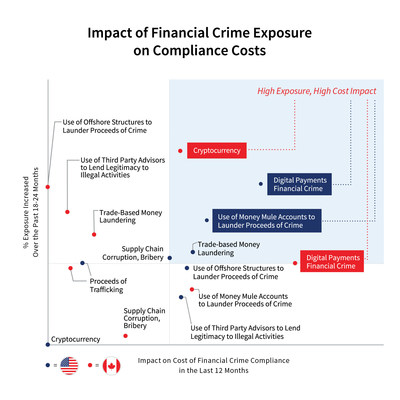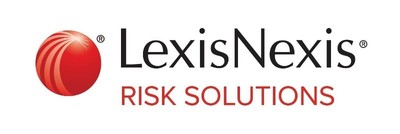LexisNexis® Risk Solutions Study Reveals Sharp Rise of Financial Crime Compliance Costs, Now Nearly $49.9 Billion Per Year for Financial Institutions in the United States and Canada
LexisNexis Risk Solutions has released its annual True Cost of Financial Crime Compliance Study for the U.S. and Canada, revealing that compliance costs have surged to approximately $49.9 billion in 2021, a 19% increase from 2020. Large U.S. financial institutions face an average compliance cost of $27.8 million, up 36% from the previous year, while Canadian firms see an average of $22.9 million. The study highlights ongoing challenges due to the pandemic, including longer onboarding times and rising operational costs as institutions adapt to evolving criminal threats.
- Financial crime compliance costs in the U.S. and Canada reached approximately $49.9 billion in 2021, indicating a significant market focus.
- Average compliance cost for large U.S. financial institutions increased to $27.8 million, reflecting heightened regulatory compliance needs.
- The pandemic has led to longer due diligence times for new account onboarding, affecting productivity.
- Increased labor costs due to expanded compliance requirements reported by 74% of U.S. firms and 88% of Canadian firms.
Insights
Analyzing...
ATLANTA, Sept. 27, 2021 /PRNewswire/ -- LexisNexis® Risk Solutions revealed the results of its annual True Cost of Financial Crime Compliance Study for the U.S. and Canada. The total projected cost of financial crime compliance for the region in 2021 is approximately
The study projects the average annual cost of financial crime compliance for U.S. financial institutions with
Pandemic Continues to Spur Growth
The pandemic continues to negatively impact compliance operations and the impact has significantly increased since the early stages of the pandemic.
- Sixty eight percent of U.S. respondents report longer times required to complete due diligence for new account onboarding due to the pandemic compared to
37% in 2020 - Fifty five percent of U.S. respondents report reduced productivity compared to
22% in 2020
Key Risk Sectors
More U.S. financial institutions now rank real estate and hospitality as top money laundering risk segments along with ecommerce. Real estate is favored by criminals who use shell companies to launder money through these types of transactions. Additionally, crime involving digital payments, trade-based money laundering and money mule schemes are on the rise with
Digital currency is a growing problem for Canadian firms with
Operational Issues
The survey results demonstrate that financial institutions are battling a broader set of issues, with challenges reported across multiple areas including resource efficiencies and customer risk profiling. Higher labor costs were fueled by increased workload from growing compliance requirements with
"The study shows clear linkages between the pandemic, digital crime and increasing regulations. As a result, financial institutions need to prepare for expanded compliance obligations and risks from emerging financial crime," said Leslie Bailey, vice president of financial crime compliance strategy for LexisNexis Risk Solutions.
Continued Bailey, "Digital transformation is a game-changer for financial crime compliance operations and will require a sophisticated approach that incorporates insight into digital behaviors and richer data to effectively mitigate risk and ensure compliance amidst growing regulatory pressures and evolving threats."
Methodology
The study surveyed 145 decision-makers in the U.S. and Canada who oversee financial crime compliance processes at their companies, including but not limited to sanctions monitoring, Know Your Customer (KYC) remediation, financial crime transaction monitoring and/or compliance operations. Responses were collected in June 2019, August 2020 and June 2021. Organizations included banks, investment firms, asset management firms and insurance firms. The total annual cost of compliance across firms was calculated using survey data on financial crime costs, as a percent of total assets and secondary data that provides the total assets for all financial institutions in the U.S. and Canada. The spend amount was generated by multiplying the average percent allocated to financial crime costs by the reported total asset amount.
Download a copy of the True Cost of Financial Crime Compliance Study for the U.S. and Canada.
About LexisNexis Risk Solutions
LexisNexis® Risk Solutions harnesses the power of data and advanced analytics to provide insights that help businesses and governmental entities reduce risk and improve decisions to benefit people around the globe. We provide data and technology solutions for a wide range of industries including insurance, financial services, healthcare and government. Headquartered in metro Atlanta, Georgia, we have offices throughout the world and are part of RELX (LSE: REL/NYSE: RELX), a global provider of information-based analytics and decision tools for professional and business customers. For more information, please visit www.risk.lexisnexis.com and www.relx.com.
Media Contact:
Marcy Theobald
678.694.6681
marcy.theobald@lexisnexisrisk.com
![]() View original content to download multimedia:https://www.prnewswire.com/news-releases/lexisnexis-risk-solutions-study-reveals-sharp-rise-of-financial-crime-compliance-costs-now-nearly-49-9-billion-per-year-for-financial-institutions-in-the-united-states-and-canada-301383351.html
View original content to download multimedia:https://www.prnewswire.com/news-releases/lexisnexis-risk-solutions-study-reveals-sharp-rise-of-financial-crime-compliance-costs-now-nearly-49-9-billion-per-year-for-financial-institutions-in-the-united-states-and-canada-301383351.html
SOURCE LexisNexis Risk Solutions









